Note from the Land of 10,000 Workflows team: This interview features our *amazing* co-editor Carolyn Bishoff, who has temporarily stepped away from her editing duties while on maternity leave but was kind enough to be interviewed by us for a change!
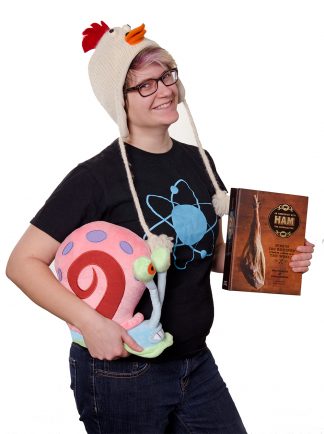 What do you do?
What do you do?
I’m the Physics, Astronomy, and Earth Sciences Librarian at the University of Minnesota and new mom to a clever and unnaturally strong baby girl.
What tools do you use to do your work?
My work as a new mom largely focuses on three activities: feeding (the baby and ourselves), changing, and sleep (for baby and ourselves). She is still too young to play much, even though she is awake and alert and can be entertained or engaged with at certain times of the day.
Feeding
She is bottle-fed breast milk and formula, so our job is to feed her whenever she cues for it. She has a particular set of faces and behaviors that tells my husband and I when she’s hungry, how much she wants to eat, and when she needs to burp. When you stare at her for hours every day, It doesn’t take long to learn these cues!
Feeding the baby is a challenge: it’s physically and emotionally demanding, especially in the middle of the night running on little sleep. We try to create spaces that make it as easy as possible, with plenty of tools to comfort her within reach as well as activities for us.
For feeding, we set ourselves up on the couch in front of the TV, a chair in the sunniest spot in the apartment, or in bed (especially if it’s early morning). Each spot has washcloths, burp cloths, and snacks within arm’s reach, and a place to put my water (especially important when I’m pumping). We also have a Boppy, a pillow that props up the baby and makes it easy to hold her close.
We feed the baby on a schedule she sets, and her schedule has developed some predictability. Many babies have a 90-minute waking cycle (similar to adults’ 90-minute sleep pattern). Sometimes it’s called the eat-play-sleep cycle but the pattern is the same: our baby will wake up, need a change, eat, have a period of active alertness, sometimes want another snack, and will be ready to sleep again, usually all within 90 minutes.
I pump and store breastmilk, which allows either my husband or I to feed the baby when she wakes up and cues for it. When she’s hungry, we warm up the milk in a bottle warmer. (We used to use a bowl of warm water to heat them up but that took so long. The baby does not like to wait.)
The bottle warmer heats her bottles really quickly and can also do some light sterilization. This thing was so inexpensive and a total game changer for us. Baby gets her food before the screaming starts (hers, and then shortly after, ours).
Washing all the feeding equipment is a many-times-daily chore. The bottles, caps, pump parts, and pacifiers need to be washed regularly with soap and water. Our trusty bottle brush, Jetz Scrubz sponge, and bottle drying rack do the job.
Once a day or every other day we also sterilize everything. My husband used to do this with a pot of boiling water. You can imagine how much fun that was. We picked up a neat, inexpensive steamer sterilizer. It’s fantastic.
It’s true that in order to take care of a kid, you have to take care of yourself. At least that’s true for us. Eating on a schedule is basically impossible with a newborn, so we don’t even bother. We try to have ready-to-eat food around the house (like those pre-cut fruit and veggie containers from the grocery store that I used to scoff at: who doesn’t have time to cut a mango? I had no idea.) Our friends set up a Meal Train for us, which has been unimaginably helpful. It’s basically the only reason we’re not eating TacoCat delivery every night, though that would be sort of cool.
If we make food, we make it to last more than one meal. One morning after the baby went back to sleep I finally made banana bread out of some frozen bananas I was saving. (You might have some of those in your freezer too.) Banana bread and muffins are great snacks for a breastfeeding person because it’s so nutritious and sticks to your ribs. I ate a lot of banana bread in the hospital after the baby was born.
Changing
Ah, stinky diapers. The ever-present reality of a tiny human. Fortunately for us, we learned very fast how to change a diaper with a high level of efficiency. My husband and I have different techniques — his is a little faster but mine makes less of a mess — and we both get the job done.
Packaging is the enemy of speed. All wipes, diapers, and cream are freed from their packaging and put within arms reach. A spare set of wipes sits in the wings in case we run out of the refillable wipes. We dress the baby here too so we have a bin for clothes that will eventually get too small, and also clothes that are labeled “0-3 months” but are inexplicably gigantic. Layers on the changing table make cleanup easy.
A small light illuminates the workspace indirectly. Our kiddo hates light in her eyes, so ceiling-mounted can lights or direct sunlight is avoided. We never turn on the overhead light in the room, partially because I broke the pull chain but also because it bothers the tiny human.
Other necessities are easy-to-reach burp cloths, washcloths, and receiving blankets. Our house can never have too many washcloths or burp cloths. The baby drools, spits up, and makes other ominous messes. We always need things to absorb baby fluids. There does seem to be an upper limit on the number of larger baby blankets we need. We usually use receiving blankets (square, lightweight blankets) for warmth, swaddling, and fluid protection rather than cleanup. It’s awfully nice to have at least a few around.
Sleep
Sleep is super important for babies. Their little brains are learning how to see and move their bodies and interpret sounds, and sleep is crucial to helping them develop and grow. Keeping the baby on her eat/play/sleep cycle means putting her to bed reliably at the end of her cycle, which tends to be around 90 minutes or so. She usually needs some help falling asleep (she hasn’t realized how great naps are yet) so we might take her on a ride in her stroller, a walk around the house, or do some rocking in her swing.
She has a full-size crib but so far has not slept in it. She sleeps in her bassinet or her Pack-N-Play. We set up the Pack-N-Play in the living room so she can sleep within earshot of us while we’re in the sunroom or watching TV, and to give one of us a break if we want to nap during the day.
Sleep is also incredibly important for us and is easily taken for granted. The old advice “sleep when the baby sleeps” is very good advice, but it can be hard. Sometimes we’re wound up, sometimes we have chores we want to finish and errands we want to run, and sometimes we just forget to wind down and sleep. Having two separate sleep areas for the baby is great. It’s also important for me to communicate when I need help getting sleep: sometimes there are messes or tasks around the house that keep me awake and take up valuable brain space. My husband and I keep each other informed of these things and help get things done for the other person’s peace of mind.
Bonus: Transportation
Walking the baby around is a good way to get her to conk out, and is also nice for us. We get out of the house (even just to the backyard) and give the kiddo a little fresh air. We have a Graco stroller/car seat system and two types of carriers: a Baby K’Tan and a Baby Bjorn.
These were little splurges for us, but they are so valuable. In the morning or evening when the baby is fussy, a little ride in the K’Tan puts her right to sleep. I can wear her while doing dishes or watering the garden, and both my hands are free.
What do I like? What do I wish worker better?
I love my dumb little Jetz Scrubz dish sponges. They’re extremely durable and don’t get gross, moldy, or stinky. We have to throw them away because they’re worn out (like in the photo above), not because they’re disgusting.
The bottle warmer actually changed our lives. I can’t imagine why we warmed up her bottles in a bowl of warm water for so long, especially when we were so sleep-deprived. It seems ridiculous.
The Baby K’Tan and Baby Bjorn carriers are the most reliable way we have to put the baby to sleep, especially when she is fussy or uncomfortable. It’s fun to carry her outside to get some fresh air and we take her on walks around the neighborhood or even just to the park near our house. The Baby Bjorn is a slick piece of equipment and is very easy and intuitive to use for us. The K’Tan is similar to a cloth wrap but it’s a fixed size, so it can be difficult to tighten, but there are a lot of cool ways I found to twist the cloth to make it secure and keep her face free from fabric.
I wish that my pump was designed better. I’m not surprised that we have things like MIT’s “Make the Breast Pump Not Suck” hackathon and groups like “Hack the Breast Pump.” It does the job fine, but I had to order different parts to make it more comfortable and there’s the issue of modesty. It’s an awkward process and can be uncomfortable. I bet a nickel that if the pump companies asked moms, we would figure out much better design solutions in no time at all.


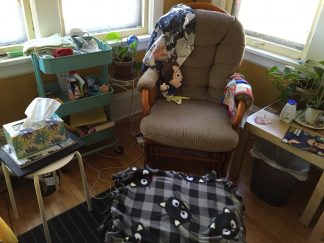
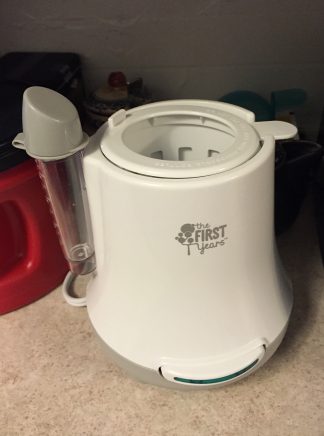
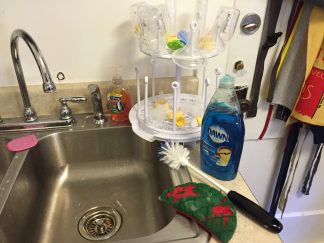
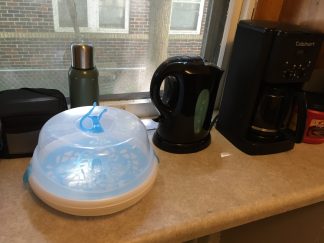
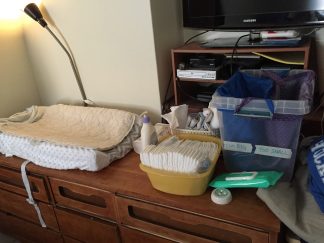
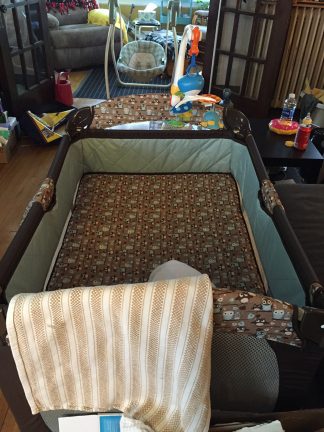
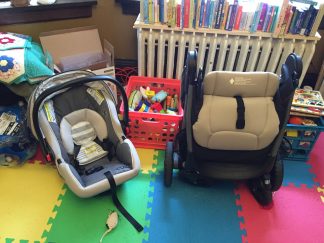
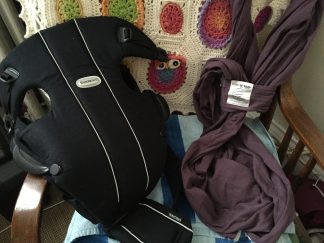



I am in awe of your organization! And you even found time to do an interview! Great work and it sounds like things are going well for you and your family.